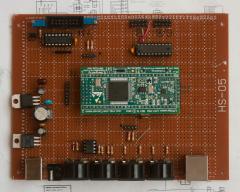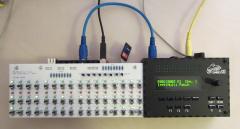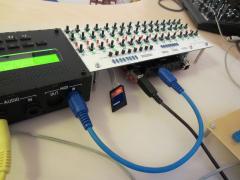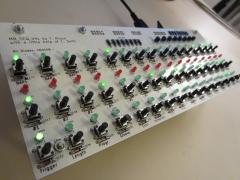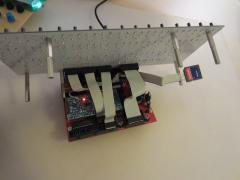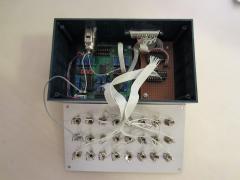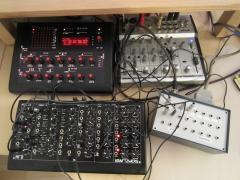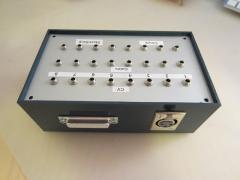-
Posts
15,247 -
Joined
Content Type
Profiles
Forums
Blogs
Gallery
Everything posted by TK.
-
I guess that you forgot to set the MIOS32_FAMILY string correctly, because it controls the memory allocation method for large arrays. The release.sh script perfectly demonstrates the correct settings - you could also use it to build a proper release with correctly set variables. However, I will release a first public version this evening together with MBSEQV4 Best Regards, Thorsten.
-
I configured my AOUT_NG module, so that CV1..4 are unipolar, and CV5..8 are bipolar. Switches won't really help, as the channels have to be calibrated when the voltage option is changed. Both! Kraftzwerg won't trigger if the voltage is below 4V, and I know from the past (multiple reports) that even a PIC can be damaged due to overvoltage if a gate output is connected to a CV output by fault. It makes sense to add a 100 Ohm resistor in serial at all gate outputs to overcome this danger. Just need some time to make it perfect :) Best Regards, Thorsten.
-
This isn't related to the bootloader, but to the firmware build itself, because it had exactly this bug on certain computers. A new version which will fix the CC issue will be available this evening. Best Regards, Thorsten.
-
Oh man, thats clear - I added a CC bandwidth optimization (mainly for MBSEQV4L) and forgot to disable it when CC values should be displayed on screen. I haven't noticed this as I only tested the changes on MBSEQV4L (without LCDs...) A new version will be available this evening. Best Regards, Thorsten.
-
-
Finally I documented all available ports at the MBHP_CORE_LPC17 page. (press the refresh button of your webbrowser if you don't see the update) The purpose(s) of J10 are described there as well. And I gave you access to the Programmers Lounge, where you will find the full history/discussions/background informations/preliminary projects/etc. ;) Best Regards, Thorsten.
-
No, this isn't possible. LEAD and DRUM are two different engines, each PIC core can only handle a single engine at the same time. You would need a second PIC + a second pair of SIDs Best Regards, Thorsten.
-
Fixed in v4.051 :) Best Regards, Thorsten.
-
V4.051 is available now: MIDIboxSEQ V4.051 ~~~~~~~~~~~~~~~~~ o improved live-recording of CCs o warning is print on screen if poly recording selected on a track with only one (or none) note layer o Drum live/step recording: disabled mapping of drum instruments to keys C/C#/D/D#/... - it was too confusing. o BPM LED Digit function: added optional 4th digit to display the value after the dot o added optional LED digits to display the current step. Anodes require a dedicated Shift Register, the 3 cathode lines can be shared with the shift register which is used to drive the cathodes of the BPM LED Digits. o added optional BPM (Tempo) encoder. As usual the pinning can be configured in the MBSEQ_HW.V4 file [/code] All reported bugs should be fixed now! I've to reject following feature requests: Since I won't be able to re-use existing code, and since I don't really want to support features which I'm unable to test by myself, especially before every release (see the errors reported by Gridracer in this thread to see what I mean) Note that the shift registers for anodes shouldn't be shared, as this would make the displays less bright (or even consume too much power) I added following feature to the wishlist - it will be implemented soon (because I like it as well): Best Regards, Thorsten.
-
The control surface PCB is up & running - no errors! Great work, Christian! :) And thanks to Nils for reviewing the design! Under the hood: sammichSID's new friend: Dimensions are matching: Now it's time to finish the case! :) Best Regards, Thorsten.
-
From the album: TK: MBSEQV4L
Dimensions are matching - now it's time to finish the case -
From the album: TK: MBSEQV4L
sammichSID's new friend -
From the album: TK: MBSEQV4L
Red/Green LEDs on a white PCB are matching nice :) -
From the album: TK: MBSEQV4L
Under the hood -

SDcard file access - multiple file handles and RAM
TK. replied to Lee's topic in MIOS programming (C)
I'm sorry, this "wording" is a bit misleading, because it refers to FatFS file handlers. But I implemented a method which allows to open multiple files with a very low memory footprint so that more files can be opened than with directly used FatFS handlers! :) Instead of the FatFS handlers, use file_t (my own structure) instead, and never access FatFS functions directly. See http://svnmios.midibox.org/filedetails.php?repname=svn.mios32&path=%2Ftrunk%2Fapps%2Fsequencers%2Fmidibox_seq_v4%2Fcore%2Fseq_file_b.c as an example Note that there are some additional seq_file_* sources in this directory for various purposes which give you more usage examples how to read/parse/write binary and ASCII files. I don't see a problem for your project, especially because reading the file will be faster than required for feeding the I2S based DAC. Usually opening a file can take some time, because FatFS has to scan the directory structure with multiple block accesses. But if you already open the samples in separate file_t handlers, switching between them will be fast and painless :) Best Regards, Thorsten. P.S.: I gave you access to the programmers lounge -
If it's working at 5V level, using a shift register is the best choice anyhow so that you will get level-shifting "for free" Yes! It only depends on your timing requirements and buffers which are added between shift registers if the load gets too high. I experienced that with up to 16 DIN/DOUT registers, no additional buffers are required (cables between shift registers should be short!) The timing depends on the bitrate you are planning to use. Multiply it with the number of bits and you will get the delay which is caused by the transfers. If you would explain more details about your project, I could give you more explicit hints... Best Regards, Thorsten.
-
You can use J28 instead, it has 4 IOs { 2, 13 }, // J28:SDA { 2, 11 }, // J28:SC { 2, 12 }, // J28:WS { 4, 29 }, // J28:MCLK [/code] The same functions as known for J5 are available. From mios32_board.h: [code] extern s32 MIOS32_BOARD_J28_PinInit(u8 pin, mios32_board_pin_mode_t mode); extern s32 MIOS32_BOARD_J28_Set(u16 value); extern s32 MIOS32_BOARD_J28_PinSet(u8 pin, u8 value); extern s32 MIOS32_BOARD_J28_Get(void); extern s32 MIOS32_BOARD_J28_PinGet(u8 pin); Best Regards, Thorsten.
-
I consider to add this to the next release, it's a simple enhancement Best Regards, Thorsten.
-
Noticed, will be fixed soon! Best Regards, Thorsten.
-
-
For inspiration: meanwhile I built an AOUT_NG module + two 74HC541 based buffer ICs into a breakout box. The 25 pin female connector is compatible to my MBSID, MBSEQ V4 and (upcoming) MBCV V2 Since the second 74HC541 had 6 spare pins, I quadrupled Clock and Start/Stop signals. But probably I will duplicate some gates later, because this is more useful (e.g. to reset analog LFOs) Cable madness! ;-) (MBSID in Bassline mode controls a semimodular analog synth via CV) Best Regards, Thorsten.
-
From the album: TK: AOUT NG Breakout Box
-
From the album: TK: AOUT NG Breakout Box


